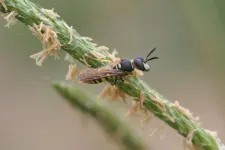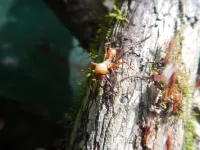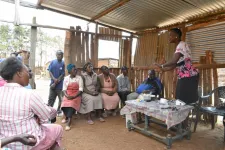(Press-News.org) Antibiotics on the cocoon protect the offspring of beewolves, a group of digger wasps, from detrimental fungi. These protective substances are produced by symbiotic bacteria of the genus Streptomyces, which live in these insects. In a new study in PNAS, researchers from the Max Planck Institute for Chemical Ecology and the University of Mainz, together with an international team, showed that these beneficial bacteria are losing genetic material that is no longer needed. The genome of these bacteria is of great interest for understanding the process of genome erosion and elucidating how the cooperation and the mutual benefit between bacteria and their host insects have evolved over long periods of time (PNAS, doi: 10.1073/pnas.2023047118, April 2021).
An ancient defensive symbiosis ensures the survival of the beewolves' offspring
Beewolves of the genus Philanthus belong to the digger wasp family and - as the name suggests - hunt bees as a food source for their offspring. They dig holes in the ground, bury their prey and lay their eggs. To protect their young from mold fungi in the warm and moist conditions in the soil, female beewolves secrete a substance from their antennae that contains symbiotic bacteria of the genus Streptomyces. These produce a cocktail of various antibiotic substances, which the beewolf larvae spin into their cocoon. This defensive symbiosis, which has existed for more than 68 million years, ensures that the beewolf offspring is well protected against harmful microorganisms.
Signs of genome erosion in the bacterial partner
The genome of the bacteria Streptomyces philanthi that are associated with the European beewolf Philanthus triangulum has now been studied in detail by a team led by Martin Kaltenpoth, director of the new Department of Insect Symbiosis at the Max Planck Institute for Chemical Ecology. "We wondered whether the long-term association with the host has resulted in changes in the symbiont's genome or shaped gene regulation and metabolic interactions between the beewolf and its bacterial partners," explains Mario Sandoval-Calderón, one of the first authors of the study, the motivation for this study.
Using state-of-the-art gene sequencing techniques, the researchers were able to read out the complete genome of the symbiont. They noticed the accumulation of "pseudogenes" that arise as a result of a reading frame shift of the coding base pairs. "These frameshift mutations in probably inactivated genes are indicators of an incipient genome erosion in Streptomyces philanthi. While the outcome of genome erosion is well characterized, its onset and the early stages are less well understood. Thus, having access to an organism in the initial stage of genomic decay can help us understand how the process starts," says study leader Martin Kaltenpoth.
Genes: reduced to the defensive symbiosis?
Further genetic analyses provided hints that the metabolism of the bacterial symbionts is mainly directed towards the production of antibiotic substances necessary for the protection of the beewolves' offspring. The unresolved question why the antibiotics are also produced in the antennae of female beewolves and then released into the brood cells via secretion of a substance containing the bacteria and the antibiotic cocktail could not be answered. Their actual defensive function has so far only been demonstrated on the cocoon. Instead, the analyses provided evidence of certain amino acids that the host must supply to its symbiotic partners in the antennal gland reservoirs because Streptomyces philanthi bacteria are no longer able to produce these nutrients themselves. Thus, is seems that beewolves even have control over antibiotic production and are able to self-regulate the benefits provided by their bacterial partners in order to optimize the protection of their offspring. Further analyses are necessary to confirm this hypothesis.
The observation that the genomic decay in the symbionts appears to be in its early stages is surprising after such a long defensive alliance with beewolves. Therefore, the scientists are now also investigating the genomes of symbiont strains associated with other beewolf species. "It seems possible that only some strains are experiencing genome erosion. Understanding the reasons for this and the factors that initiate this process could help us to gain valuable insights into the forces that govern genome evolution more generally," Martin Kaltenpoth hopes.
Modern molecular tools make it increasingly possible to study the interactions between living organisms from the level of individual molecules to ecological and evolutionary questions - even in non-model organisms. Applying them to the manifold symbioses between insects and their bacterial partners may help to better understand the interactions between these organisms, their mutual benefits as well as their co-evolution.
INFORMATION:
Original Publication:
Nechitaylo, T. Y., Sandoval-Calderón, M., Engl, T., Wielsch, N., Dunn, D. M., Goesmann, A., Strohm, E., Svatoš, A., Dale, C., Weiss, R. B., Kaltenpoth, M. (2021). Incipient genome erosion and metabolic streamlining for antibiotic production in a defensive symbiont. Proceedings of the National Academy of Sciences of the United States of America, doi: 10.1073/pnas.2023047118
https://doi.org/10.1073/pnas.2023047118
Further Information:
Prof. Dr. Martin Kaltenpoth, e-mail kaltenpoth@ice.mpg.de, +49 3641 57 1500, Max-Planck-Institut für chemische Ökologie, Hans-Knöll-Straße 8, 07745 Jena
Contact and Picture Requests:
Angela Overmeyer M.A., Max Planck Institute for Chemical Ecology, Hans-Knöll-Str. 8, 07743 Jena, Germany, Tel. +49 3641 57-2110, E-Mail overmeyer@ice.mpg.de
Download of videos and high-resolution images via http://www.ice.mpg.de/ext/downloads2021.html
Police violence against Black Americans is shamefully common in the United States and devastates communities. For incidents that get widespread media exposure, a collective trauma is felt across the nation, especially for Black individuals. Research supports that experiencing racism even vicariously can harm the mental and physical health of others of the same racial group, yet its effect on a population level is unclear.
A new study analyzed how highly publicized acts of racial violence impacted the mental health of Black Americans in the U.S. The authors identified 49 incidents that occurred between 2013 and 2017, including police killings of Black individuals, hate-crime murders and decisions not to indict or convict the officers involved. The researchers measured ...
What keeps some plants squatting close to the soil while others - even those closely related - reach high for the skies?
New research addressing the architecture and growth habit of plants has provided an answer to this question and may assist in the development of better performing crops.
The way plants grow must sometimes satisfy contradictory needs. Growing close to the ground, decreases the chances of being grazed, but this presents the need to rise rapidly to allow seeds to disperse. This can be observed in dandelions and in Arabidopsis, a model species commonly used to study plant development.
Agriculture has taken advantage of the diversification of growth habit so that ...
Like superheroes capable of seeing through obstacles, environmental regulators may soon wield the power of all-seeing eyes that can identify violators anywhere at any time, according to a new Stanford University-led study. The paper, published the week of April 19 in Proceedings of the National Academy of Sciences (PNAS), demonstrates how artificial intelligence combined with satellite imagery can provide a low-cost, scalable method for locating and monitoring otherwise hard-to-regulate industries.
(WATCH VIDEO: https://www.youtube.com/watch?v=LHvRgKmJOK8)
"Brick kilns have proliferated across Bangladesh to supply the growing economy with construction materials, which makes it really hard for regulators to keep up with new kilns that are constructed," ...
A new type of collective behaviour in ants has been revealed by an international team of scientists, headed by biologist Professor Iain Couzin, co-director of the Cluster of Excellence "Centre for the Advanced Study of Collective Behaviour" at the University of Konstanz and director at the co-located Max Planck Institute of Animal Behavior, and Matthew Lutz, a postdoctoral researcher in Couzin's lab. Their research shows how ants use self-organized architectural structures called "scaffolds" to ensure traffic flow on sloped surfaces. Scaffold formation results from individual sensing and decision-making, ...
Researchers at Baylor College of Medicine and collaborators at other institutions have discovered that POT1, a gene known to be associated with risk of glioma, the most common type of malignant brain tumor, mediates its effects in a sex-specific manner. Researchers found that female mice with glioma that lacked the gene survived less than males. This led them to investigate human glioma cells, where they found that low POT1 expression correlated with reduced survival in females.
Published in the journal Cancer Research, the study also shows that, compared to males', female tumors had reduced expression of immune signatures and increased expression of cell replication markers, suggesting that the immune response and tumor cell proliferation seemed to be ...
Scientists at VCU Massey Cancer Center have identified a protein that operates in tandem with a specific genetic mutation to spur lung cancer growth and could serve as a therapeutic target to treat the disease.
Mutations in the p53 gene are found in more than half of all cancers, but it remains difficult to effectively target the gene with drugs even decades after its discovery. Though previous research has shown that p53 acts as a tumor suppressor and initiates cancer cell death in its natural state, a new study led by Sumitra Deb, Ph.D., suggests that gain-of-function (GOF) mutations -- a type of mutation where the changed gene has an added function ...
LOS ALAMOS, N.M., April 19, 2021--A new machine-learning program accurately identifies COVID-19-related conspiracy theories on social media and models how they evolved over time--a tool that could someday help public health officials combat misinformation online.
"A lot of machine-learning studies related to misinformation on social media focus on identifying different kinds of conspiracy theories," said Courtney Shelley, a postdoctoral researcher in the Information Systems and Modeling Group at Los Alamos National Laboratory and co-author of the study that was published last week in the Journal of ...
PHILADELPHIA-- A retrospective study led by researchers from Penn Medicine found that with MitraClip for treatment of secondary mitral regurgitation (MR), a heart disease associated with problems in the left ventricle, there was no negative effect of having a slightly smaller mitral valve opening as long as there was good reduction of the mitral regurgitation. The study is published today in JACC: Cardiovascular Interventions.
"This data is very reassuring for physicians who place MitraClips in patients with secondary mitral regurgitation. It demonstrates that the benefits of MR reduction in patients with heart failure were maintained even when mild-to-moderate mitral stenosis, which can be caused by a narrowing of the ...
While cardiovascular disease (CVD) remains the leading cause of death globally, new research led by NYU Grossman School of Medicine and Moi University School of Medicine (Kenya) found that addressing and incorporating social determinants of health (such as poverty and social isolation) in the clinical management of blood pressure in Kenya can improve outcomes for patients with diabetes or hypertension.
The study -- recently published online in The Journal of the American College of Cardiology - found that after one year, patients who received a multi-component intervention that combined community microfinance groups with group medical visits (where patients with similar medical conditions met together with a clinician and community health worker) ...
A first-of-its-kind study led by The University of Texas at Austin has found that rock weathering and water storage appear to follow a similar pattern across undulating landscapes where hills rise and fall for miles.
The findings are important because they suggest that these patterns could improve predictions of wildfire and landslide risk and how droughts will affect the landscape, since weathering and water storage influence how water and nutrients flow throughout landscapes.
"There's a lot of momentum to do this work right now," said study co-author Daniella Rempe, an assistant professor at the UT Jackson School of Geosciences Department of Geological Sciences. "This kind of data, across large scales, is what is needed to inform next-generation models of land-surface processes."
The ...





